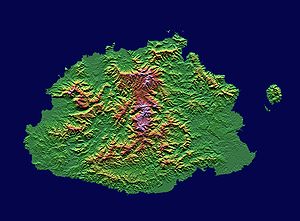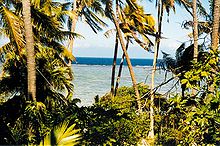Viti Levu

E duaViti Levu(pronounced[ˈβitʃi ˈleβu]) sai koya nayanuyanulevu duadua ena loma ni vanua oViti,na vanua e tiko kina na mata ni matanitu, eSuva,kei na itikotiko vei ira e vuqa sara na lewe levu ni iwiliwili nei Viti.
Geology[veisau|edit source]
Fiji lies in atectonically complex areabetween theAustralian Plateand thePacific Plate.The Fiji Platform lies in a zone bordered with active extension fault lines around which most of the shallow earthquakes were centered. These fault lines are the Fiji Fracture Zone (FFZ) to the north, the176° Extension Zone(176°E EZ) to the west, and the Hunter Fracture Zone (HFZ) and Lau Ridge to the east.[1]
The oldest rocks on the island consist of theEocenetoLower MioceneWainimalaGroup.The Lower portion of the Group are composed ofvolcanicflows and volcanoclastics, which grade frombasalttotrachyteandrhyolite.Geographically, this group is found south ofNadi,including the peaks of Koromba (3528’) and Natambumgguto (1242’), down toSigatoka.From Sigatoka, the Group extends almost all the way to Lodoni, and includes the peaks of Tuvutau (3060’) and Tikituru (3071’), while along the southern coast it extends almost toNausori.The Group isintrudedby the TholoPlutonicsconsisting of similar agestocksoftonalite,granodiorite,gabbroanddiorite.Mio-Pliocenesandstonesandmarl,grading into epiclastics andandesiticvolcanics of the Suva Group are found mainly in the river valleys such as those formed by theNadi RiverandNavua River.The Plio-PleistoceneMba Grouop is found on the northern portion of the island and consists ofporphyriticbasalt flows and volcanoclastics grading intogreywacke.Geographically it includes the peaks of Koroyanitu (3921’), Malua (3294’), Monavatu (3708’),Mount Tomanivi(4341’), and Ndelamendamu (2540’), and extends along the eastern coast almost to Nausori. It also includes the Emperor Mine nearVatukoula.[2][3]
Geography and economy[veisau|edit source]

Viti Levu is the largest island in the nation, home to 70% of the population (about 600,000), and is the hub of the entire Fijian archipelago. It measures 146 kilometres (91 mi) long and 106 kilometres (66 mi) wide, and has an area of 10,389 square kilometres (4,011 sq mi).Earthquakesand volcanic eruptions account for the somewhat rugged terrain of the island, which is divided into roughly equal halves by a north-south mountain range. The centre of the island is forested and includes the nation's highest peakMount Tomanivi(otherwise Mount Victoria) rising to 1,324 metres (4,344 ft).
The eastern side of the island experiences heavy rainfall, while the western side (colloquially called the "burning west" ) is noticeably drier in the range'srain shadow.Accordingly,sugar caneproduction thrives in the west, while adairyindustry is being built in the east.[citation needed]Fiji's biggest cattle ranch is at Yaqara, with 7000 head of cattle on its 70 square kilometres (17,000 acres), located halfway betweenTavuaandRakiraki.The island is the only known home of one of the world's largest insects, theGiant Fijian long-horned beetle.
Localities[veisau|edit source]


Viti Levu hosts the capital city ofSuva,and is home to nearly three quarters of the population of the Republic (about 580,000). Other important towns, all around the coast, includeBa,Lautoka,Nadi,Nausori,Rakiraki, andSigatoka.One major road has been built around the perimeter of Viti Levu. Well-known localities includeNatadola Beach,Pacific Harbour(a resort center about 50 kilometers from Suva).
Politics[veisau|edit source]
Eight of Fiji's fourteenProvincesare in Viti Levu. The Provinces ofBa,Nadroga-Navosa,andRacomprise theWestern Division,whileNaitasiri,Namosi,Rewa,Serua,andTailevuform theCentral Division.In part because of its high concentration ofIndo-Fijians,whose ancestors came mostly as indentured workers fromIndiabetween 1879 and 1916, the political dynamics of western Viti Levu are somewhat different from those of eastern Viti Levu, where, apart from the multi-racial urban areas,indigenous Fijiansare more heavily concentrated.
History[veisau|edit source]
Viti Levu is believed to have been inhabited longer than the northern island ofVanua Levu.According to oral traditions, the firstMelanesiansettlers landed atVuda Pointand establishedViseisei,believed to be Fiji's oldest settlement, although archaeologists refute this claim.
Other[veisau|edit source]
The Canadian entrepreneurPeter Munknamed hisKlostershouse after the island, as Viti Levu was where he andDavid Gilmourstarted theSouthern Pacific Hotelchain in the 1960s.[4]
Veitikina[veisau|edit source]
- ↑Greenbaum, D.; Bowker, M. R; Dau, I; Drospy, H; Greally, K. B; McDonald A. J. W; Marsh, S. H; Northmore, K. J; O'Connor, E. A; Prasad, R. S & Tragheim, D. G. (1995)."Landslide hazards in Fiji"(PDF).Technical Report WC/95/28 Rapid methods of landslide hazard mapping: Fiji case study.British Geological Survey.Retrieved23 March2011.
- ↑Provisional Geologic Map of Fiji.Suva: Fiji Geological Survey. 1965.
- ↑Rodda, P. (1967). "Outline of the geology of Viti Levu".New Zealand Journal of Geology and Geophysics.10(5): 1260–1273.doi:10.1080/00288306.1967.10420217.
- ↑"Peter Munk: A mining magnate nears the end of his golden reign" ERIC REGULY.The Globe and Mail15 March 2014
| Wikimedia Commons has media related to:Viti Levu |
